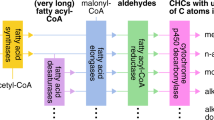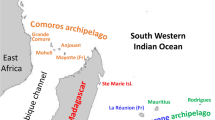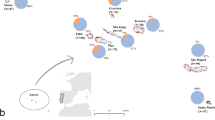Summary
New South Wales and southern Queensland populations of two eusocial, stingless bees, (Trigona carbonaria and T. australis) were examined for enzyme variation at 20 gene loci. The high level of interspecific variation (60 per cent fixed gene difference) contrasted sharply with the absence of intraspecific variation over a 1400 km range. Factors which might underlie this effect such as reduced heterozygote advantage, inbreeding and low environmental variability within and between nests are discussed.
Similar content being viewed by others
Article PDF
References
Avise, J C. 1976. Genetic differentiation during speciation. In Ayala, F. J. (ed.) Molecular Evolution, Sinauer Associates, Inc., Massachusetts, pp. 106–122.
Avise, J C, and Selander, R K. 1972. Evolutionary genetics of cave-dwelling fishes of the genus Astyanax. Evolution, 26, 1–19.
Bonnell, M L, and Selander, R K. 1974. Elephant seals: genetic variation and near extinction. Science, 184, 908–909.
Foltz, D W, Ochman, H, Jones, J S, Evangelisti, S M, and Selander, R K. 1982. Genetic population structure and breeding systems in arionid slugs (Mollusca: Pulmonata). Biological Journal of the Linnean Society, 17, 225–241.
Harris, H, and Hopkinson, D A. 1976. Handbook of Enzyme Electrophoresis in Human Genetics. North-Holland Pub. Co., Amsterdam.
Hartl, D L. 1971. Some aspects of natural selection in arrhenotokous populations. American Zoologist, 11, 309–325.
Kimura, M, and Ohta, T. 1971. Theoretical Aspects of Population Genetics. Princeton University Press, Princeton.
Pamilo, P, Rosengren, R, Vepsäläinen, K, Varvio-Aho, S, and Pisarski, B. 1978a. Population genetics of Formica ants: 1. Patterns of enzyme gene variation. Hereditas, 89, 233–248.
Pamilo, P, Varvio-Aho, S, and Pekkarinen, A. 1978b. Low enzyme gene variability in Hymenoptera as a consequence of haplodiploidy. Hereditas, 88, 93–99.
Powell, J R. 1975. Protein variation in natural populations of animals. Evolutionary Biology, 8, 71–119.
Selander, R K, Kaufman, D W, Baker, R J, and Williams, S L. 1974. Genie and chromosomal differentiation in pocket gophers of the Geomys bursarius group. Evolution, 28, 557–564.
Snyder, T P. 1974. Lack of allozymic variability in three bee species. Evolution, 28, 687–698.
Webster, T P, Selander, R K, and Yang, S Y. 1972. Genetic variability and similarity in the Anolis lizards of Bimini. Evolution, 26, 523–535.
Zucchi, R, and Sakagami, S F. 1972. Thermoregulatory capacity of Trigona spinipes and some other species of stingless bees. In Homenagem à Warwick E Kerr, Faculade de Filosofia, Ciências E Letras, Rio Claro, pp. 301–309.
Author information
Authors and Affiliations
Rights and permissions
About this article
Cite this article
Wagner, A., Briscoe, D. An absence of enzyme variability within two species of Trigona (Hymenoptera). Heredity 50, 97–103 (1983). https://doi.org/10.1038/hdy.1983.12
Received:
Issue date:
DOI: https://doi.org/10.1038/hdy.1983.12
This article is cited by
-
Anthropogenic hive movements are changing the genetic structure of a stingless bee (Tetragonula carbonaria) population along the east coast of Australia
Conservation Genetics (2018)
-
Isoenzyme Variation in Melipona rufiventris (Hymenoptera: Apidae, Meliponina) in Minas Gerais State, Brazil
Biochemical Genetics (2005)
-
Glycerol-3-phosphate dehydrogenase (G-3-PDH; EC 1.1.1.8) variation in Brazilian stingless bees and in wasp species
Biochemical Genetics (1991)
-
High level of genetic heterozygosity in the hyperparasitic wasp,Mesochorus nigripes
Experientia (1986)



